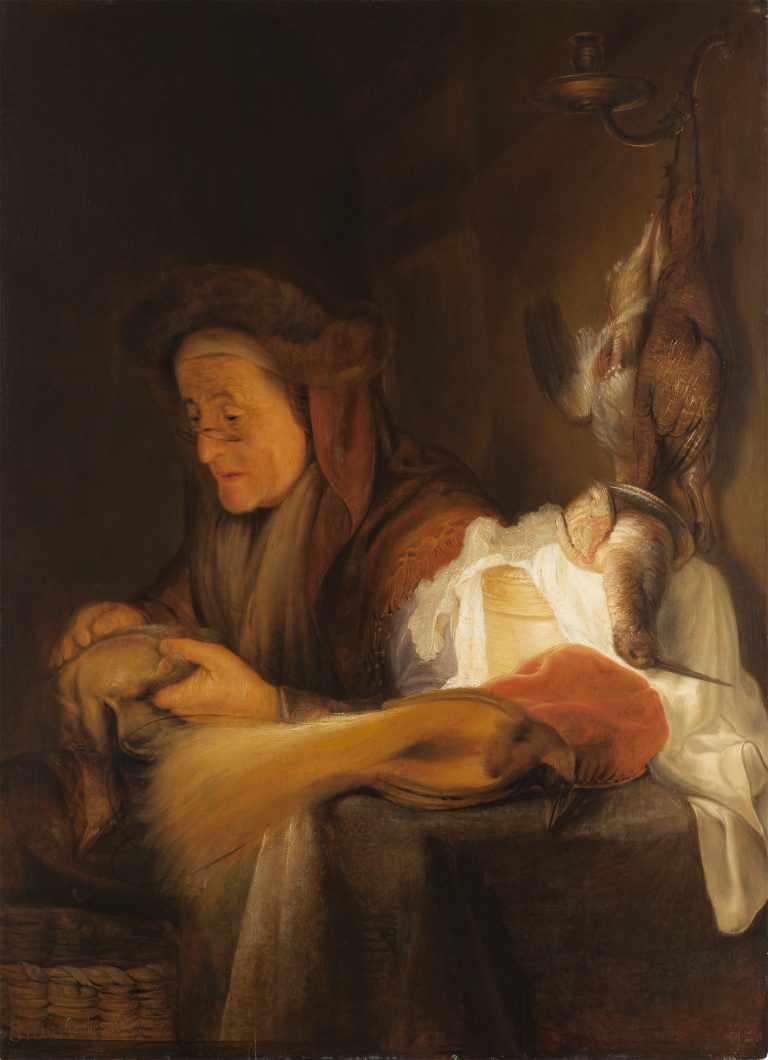In a composition dominated by a warm palette of deep red, ochre, and brown hues, an old woman holds a dead duck above a wicker basket as she carefully plucks the last few feathers off its bare belly. Peering through spectacles perched on her nose, the woman’s squinting eyes, raised eyebrows and slightly parted lips betray her total concentration as she attempts to remove every feather from the duck’s body. To seventeenth-century viewers, the woman’s care in properly preparing a meal would have have been an exemplar of female domestic virtue.1
Lying on the table in front of the woman is an exotic, white bird of paradise, identifiable by its elegant tail with distinctive fine plumage, framed by two black filamentary feathers. The red velvet beret next to its head foreshadows the bird’s ornamental destination: the woman will soon attach the feathers to the hat with a needle and thread—another reference to domesticity—to create an elegantly adorned beret similar to one depicted by Dirck de Bray in 1672 (fig 1).2 Against the wall at the right is a dead snipe that gracefully hangs over the edge of a round box covered by a white satin cloth. Suspended from an empty sconce on the wall above the snipe, to be tenderized before being plucked and consumed, are a dead partridge and a chicken.3 As much as these four dead fowls present a glorious display of lush materials and various colorful bird feathers, they are also a subtle reference to the woman’s old age and the foreshadowing of her imminent end.4
Although the painting is signed “Renbrant” [sic] in the lower left corner, this signature is spurious and the artist of the work, who was probably associated with Rembrandt’s workshop, has not been identified.5 This unknown master used strong lighting to accentuate the chicken, the partridge and the snipe, and painted these birds with much detail, particularly in the feathers, where he added shimmering highlights in raised impasto. In contrast, he left the woman and the bird of paradise in shadow, and executed their forms with muted colors and broad brushstrokes. The subdued cream-colored hues used in rendering the smooth, silky feathers of the bird of paradise are comparable to the broad handling seen in the woman’s flowing scarf.
Another more tightly cropped version of this composition is in the Michaelis Collection in Cape Town, where it is also attributed to the School of Rembrandt (fig 2). The relationship between these two works is unclear and probably cannot be determined with certainty until they are compared side by side. The few pentimenti in the Leiden Collection painting occur either in areas of the composition that fall outside the Cape Town version, or are too minor to indicate which of the two paintings is the primary version.7 Werner Sumowski considered the Cape Town painting to be of better quality than the present work.8 Indeed, the execution of that work is more carefully rendered in many areas, specifically in the hair on the woman’s proper left temple, the ornamental element on the woman’s upper sleeve, and the feathers of the tail of the bird of paradise, all of which suggests that the Cape Town work is the primary version of this composition.
In the early twentieth century, both paintings were considered to be by Rembrandt.9 By the 1940s scholars recognized that although the general composition, stark lighting, and figure type are reminiscent of Rembrandt, the execution of neither work was by the master.10 Attributions to a specific artist in Rembrandt’s studio, including Abraham van Dyck (1635–72), Arent de Gelder (1645–1727), Christopher Paudiss (1630–66), and Karel van der Pluym (1625–72), however, have proven to be unconvincing.11
Sumowski noted that the facial features and spectacles of the woman in this composition are strikingly similar to those of the old servant in Rembrandt’s 1643 Toilet of Bathsheba (fig 3). On this basis, he proposed a dating of the present work to ca. 1645–50.12 This dating corresponds with the results of dendrochronological analysis, which reveal that the youngest year ring can be dated to 1629. The panel, thus, could have been ready for use by around 1646. Another connection to Rembrandt’s work from this period is the arrangement of brightly lit dead birds in the foreground and a shaded figure in the background, which is reminiscent of Rembrandt’s 1639 Self-Portrait with Dead Bittern14 and his Still Life with Peacocks of ca. 1639 (fig 4). Although we do not know who executed the present painting, it clearly reflects the impact of Rembrandt’s manner in the mid-1640s.
